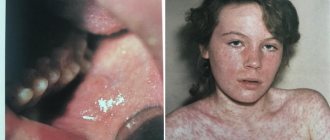Many parents at the appointment worriedly ask the pediatrician why their baby should be vaccinated against hepatitis B so early? Where can someone so small get infected? In fact, hepatitis can now occur in both a newborn and an ancient old man. In modern living conditions, no one is safe from it. Why is hepatitis so dangerous, and why do pediatricians insist on vaccination? Let's understand this complex problem in more detail.
About hepatitis B itself
Hepatitis B is an infectious disease that is of interest not only to pediatricians, infectious disease specialists and scientists. The disease has a high social significance on a par with tumor diseases, hepatitis C and HIV infection.
The disease is caused by a specific hepatitis B virus, which, when it enters the body, causes inflammatory changes in the liver tissue. Moreover, there are various forms of the disease - from asymptomatic carriage of the virus to jaundice, cirrhosis, liver cancer and acute liver failure. Let me give you some statistics - according to official WHO data, up to 2 billion people around the world have been diagnosed with the hepatitis B virus or antigen, approximately 300 million are registered chronic carriers, and about 1 million people die from the consequences of hepatitis every year . And about a third of them are children, teenagers and young people under 20 years old.
Where can a child become infected?
You can become infected with hepatitis B in different ways; there are several ways the virus enters the body. This is possible not only when transfusing blood and its components, when performing medical manipulations with non-disposable instruments, by “through a needle,” which is common among drug addicts. The virus is transmitted sexually, there is transmission of the virus from mother to child, household contacts in the family with patients or virus carriers.
Different options are relevant for different age groups of children. For newborns, the most relevant route of transmission is “vertical” - from the mother during childbirth. The fact is that the hepatitis B virus does not penetrate a normally functioning placenta. Therefore, only children of mothers who have severe pathologies of the placental barrier can become infected during pregnancy. But during childbirth, the likelihood of infection increases sharply. Of course, doctors make a lot of efforts to minimize this risk. But this is only when the mother is confirmed to be a carrier or disease. What if she is infected, but the virus is still in the incubation stage? Then she can pass it on to the baby.
Is it possible that the child was infected with viral hepatitis in the maternity hospital, and not from the parents? This can't happen. All personnel who work in maternity hospitals are constantly having their blood taken for analysis and are required to be vaccinated against hepatitis B. Not a single doctor, midwife or nurse will be hired to work in such an institution if they are not vaccinated!
The second option for the route of infection for an infant is a blood transfusion in case of Rh conflicts, hemolytic anemia or other pathologies that occur during childbirth and immediately after it. Some doctors insist that the virus can be transmitted to mothers who are breastfeeding, but this theory is controversial. There is also an opinion that if there is close contact in the family, the baby will certainly become infected from a sick family member in the next 3-5 years of his life. But this can only happen if he is not vaccinated!
For children over one year old, various medical interventions come to the fore in the likelihood of infection - operations, treatment and removal of teeth (if this is done with reusable instruments), transfusions of blood or its components. The second point is household contact with infected family members.
For children and adolescents from 13 to 18 years old, all of the above are joined as probable routes of infection by those that are common for adults - sexually and “through a needle”. It's no secret how the teenage subculture is developing now. Therefore, parents of teenagers need to closely monitor the social circle of their boys or girls and pay attention to the slightest changes in their behavior.
However, dear parents, you should know that hepatitis B is not transmitted through water and food, by shaking hands or by airborne droplets.
Hepatitis vaccinations for newborns!!!
Recently, the spread of viral hepatitis B has become increasingly alarming. Let's talk about hepatitis vaccinations for newborns.
Like AIDS, viral hepatitis B is transmitted through contact with the blood of an infected person, but hepatitis B is 100 times more contagious than AIDS. In the world, more than a quarter of a million people are infected with this disease every year, of which about 50,000 are in our country. There is no effective treatment for hepatitis B virus. Fortunately, there is a simple way to prevent this disease - hepatitis vaccination .
What is hepatitis B
Hepatitis B (from the Greek word hepar - “liver”, since hepatitis damages the cells of this organ) is an acute viral disease. At the onset of the disease, the patient experiences symptoms that resemble those of a common acute respiratory infection (by the way, there are cases when the disease throughout its entire duration is limited to only these symptoms; in these cases, hepatitis B often remains unrecognized: it is mistaken for a cold). Then jaundice appears (yellow discoloration of the skin and mucous membranes), as well as loss of appetite, nausea, vomiting, pain in the upper abdomen, darkening of urine and discoloration of feces. It should be noted that in newborns, hepatitis in 90-95% of cases is asymptomatic, i.e. without “classic” jaundice.
Most often, hepatitis lasts 3-6 weeks and ends with complete recovery. But in 1-2% of cases the disease develops into so-called “fulminant” hepatitis, the mortality rate of which is up to 93%. In addition, there is a danger of the disease transforming into the form of chronic hepatitis (5-10% of all hepatitis sufferers suffer from it). Chronic hepatitis, in turn, can lead to cirrhosis and liver cancer.
Unfortunately, chronic hepatitis in children is more common than in adults: the probability of chronic infection in children aged 1 to 5 years who contract hepatitis is up to 50%, and in children who contracted hepatitis in the first year of life – up to 90%.
Hepatitis B infection occurs through contact with the blood of an infected person. Thus, this disease can be transmitted:
- during transfusion of blood or its components, through indirect contact with the patient’s blood (“syringe” route of infection, common among drug addicts, transmission through reusable medical instruments);
- sexually (hetero or homosexual contacts);
- from mother to child during childbirth;
Hepatitis vaccinations for newborns
Parents need to remember that timely vaccination against hepatitis B will ensure the health of their child in the future. In addition, as already mentioned, it is newborns who have the maximum risk of becoming chronic carriers of the infection. Vaccination is designed to protect those babies born to mothers who are carriers of the hepatitis virus.
Transfer of hepatitis B from an infected mother to the fetus occurs during childbirth in 95% of cases. In addition, it is believed that if the virus was not transmitted to the child during childbirth, and the vaccination was not given, then “family” infection will certainly occur over the next 5 years. Therefore, it is especially important to vaccinate children born to mothers who are carriers of the hepatitis B virus in the first hours after birth in order to “get ahead” of the virus. The argument in favor of vaccinating newborns is that before the age of one year, vaccination against hepatitis is more effective and that the reliability of modern tests for hepatitis B is not one hundred percent reliable. It is no coincidence that in developed countries, vaccination against hepatitis B is included in the compulsory vaccination calendars and actually begins from the first days of a child’s life. It was also included in the Russian vaccination calendar.
The standard course of hepatitis vaccinations for newborns consists of three vaccinations. The first two can be considered as initial doses, while the third is designed to boost the production of antibodies in those vaccinated and provide long-term protection against the virus.
An approximate schedule of vaccinations against hepatitis for newborns :
- 1st injection: selected date (for newborns - usually 12 hours after birth);
- 2nd injection: 1 month after 1st injection;
- 3rd injection: 6 months after the first. The main principle for determining the regimen is that the interval between two vaccine injections must be at least 1 month. That is, such schemes as: 1 month, 3 months, 6 months are also quite applicable; 1 month, 6 months, 12 months, although it is better to stick to the standard scheme of 0-1-6 months.
For children born to mothers who are carriers of the hepatitis B virus, a different regimen is used, consisting of 4 injections.
The child's parents also need to be aware of the circumstances that require special care when administering hepatitis vaccinations to newborns . Let's list them:
- a strong unusual reaction to the first injection of the vaccine;
- yeast allergy;
- severe infectious disease (in this case, vaccination is postponed until the condition improves).
There is no data yet on the use of the vaccine in pregnant women. However, the fact that the vaccine does not contain live viruses suggests that the vaccine is safe to use during pregnancy.
About vaccines
In Russia, only so-called “yeast” recombinant vaccines are used. This is currently the most widely used class of vaccine in the world to prevent hepatitis B.
How are such vaccines prepared, and what does yeast have to do with it? Recombinant technology is a technique from the arsenal of genetic engineering. It consists of the following: a gene responsible for the production of one of the components of the hepatitis B virus (the so-called Australian antigen, or HBsAg) is inserted into the genetic material of ordinary baker's yeast. In the process of reproduction of such yeast, this piece of the virus grows (the expression “by leaps and bounds” could not be more appropriate here). Then it is cleaned of ballast and yeast - and the vaccine is ready. Of course, when preparing it, all kinds of tests are carried out - for sterility, for purity, etc. The vaccines obtained in this way are unusually pure - up to 95% of the vaccine content is pure antigen, i.e. immune-forming component. In addition, they are economical because they do not use expensive components. When introduced into the human body, the Australian antigen is perceived by the immune system as a sign of infection, although in fact it has nothing in common with the live virus and it is impossible to get sick as a result of vaccination. As a result, antibodies are produced, and the person becomes immune to the disease.
Six vaccines against hepatitis B are registered in Russia. Among them there are both domestic and imported drugs. They are all produced using the same recombinant technology and are almost identical. All hepatitis B vaccines are interchangeable: a course of vaccinations can be started with one vaccine and completed with another, although it is preferable to use a vaccine of the same brand, from the same production batch.
The frequency of adverse reactions is fairly standard for all vaccines: up to 10% of vaccinated people report local reactions - thickening and redness of the skin at the injection site. Less commonly (up to 5% of vaccinations) a temperature reaction occurs - an increase in body temperature to 37.5-38 degrees. All reactions appear within 1-2 days and disappear within about two days.
What is the danger of hepatitis B?
An infected person poses a danger to his healthy environment. And you should always remember this. The hepatitis virus is hundreds of times more contagious than HIV - if HIV infection requires several milliliters of blood entering the bloodstream, or prolonged contact with infected blood, then for hepatitis sometimes one prick with an infected needle or breaking the integrity of the skin with an instrument that is infected with hepatitis is enough. The virus is so small and reproduces so actively that it penetrates well through the mucous membranes of the mouth, eyes, nose and genital tract.
The virus itself does not destroy liver cells. It is integrated into the structure of the cell in order to multiply inside it, leaving a kind of “beacons” on its surface. These “beacons” signal to the immune system that the cell has been captured by an enemy. And although it is its own, a command is given to the immune system to destroy it, and self-destruction of the liver tissue occurs - this is called autoimmune damage. The liver is destroyed as a result of an immune attack from its own body. If this affects a large part of the liver. And then acute liver failure develops.
The liver has a good reserve for regeneration (repairing damage), but, however, due to viruses, transformation of the genetic material occurs, and cancerous foci form in the liver. Then liver carcinoma (cancer) develops. In the most favorable case, acute inflammation develops in response to the penetration of the virus and the classic picture of hepatitis with jaundice, poor health, and a characteristic clinical picture. This disease ends in recovery.
Unfortunately, in our young patients the classic icteric course is rare. The younger the baby is, the greater the likelihood of an asymptomatic course or carriage, which will turn into chronic incurable hepatitis B. For newborns, this is a 95% chance. For children under three years old - up to 80%. With age, the percentage decreases, making the probability of illness with jaundice more than 30-40% in adults, and the risk of becoming chronic is 6-10%.
All this is due to the peculiarities of the immune system - the younger the child, the lower its antiviral activity, the greater the likelihood for the virus to freely settle and multiply in the baby’s body. If a child has hepatitis B, which occurs with jaundice, parents should be happy - this means that the baby’s immune system is actively resisting, and the risk of becoming chronic is minimal.
When liver cells are destroyed, bile enters the blood, which is why signs of jaundice appear - staining of the skin and mucous membranes, changes in the color of stool and urine. And it is this symptom that forces parents to seek help from a doctor.
Quite often, hepatitis occurs like an acute respiratory viral infection or influenza, with fever, loss of appetite, weakness, mild pain in the abdomen and side, and therefore is detected later - when examining the blood and detecting a specific “Australian antigen” in it. And this shocks parents, because the incubation period of hepatitis B lasts from forty to one hundred and eighty days (the average is usually one hundred and twenty days). This is approximately 4 months. Therefore, it is sometimes very difficult to remember and establish exactly where and how the infection could have occurred. And given the long-term asymptomatic carriage, sometimes it is impossible to determine the source at all. All members of the child's family will be examined. And perhaps those who had been in contact with him for a long time.
Why is the virus dangerous?
Hepatitis B is a disease caused by the HBV virus. The virus has a pronounced hepatotropic effect, that is, when it enters the body, it destroys the main cells of the liver - hepatocytes. Due to extensive damage, the organ ceases to perform its functions, which affects the general condition, leads to intoxication, and metabolic disorders. Acute infection may be accompanied by jaundice, mild malaise, or be asymptomatic. Often the disease remains undiagnosed or is detected accidentally.
The clinical picture of the disease is explained by the destruction of liver cells and impaired bile outflow. Due to the accumulation of toxins, the entire body suffers, primarily poisoning affects the cells of the nervous system.
- After the acute phase, the virus either dies or the disease becomes chronic. If the virus dies, a strong immunity is formed in the body, liver cells are restored over time, and the functions of the organ are normalized.
- As hepatitis becomes chronic, hepatocytes are gradually replaced by connective tissue cells, which leads to fibrosis, cirrhosis and organ failure. In some cases, liver cancer develops. The chronic form is characterized by periodic exacerbations.
The development of chronic hepatitis B occurs in 95% of infected newborns; in adults, the proportion of pathology that becomes chronic is 5%. It is for this reason that neglecting vaccinations is dangerous. The first must be done within the walls of the maternity hospital, further revaccinations are carried out according to the approved vaccination schedule.
Diagnosis and treatment of hepatitis B
As we have already said, the disease or carrier status can be confirmed if a specific marker is detected in the child - the “Australian” or surface antigen. To do this, blood is taken from a vein. Further studies are carried out to determine the stage of infection; they are used to assess the extent of liver inflammation and the degree of its damage by the virus.
There is no specific tablet, injection or powder for hepatitis B that would completely cleanse the body of viruses and is unlikely to appear in the near future. Treatment is carried out only symptomatically - that is, the inflammatory process is reduced, the reproduction of viruses and their destruction of cells are suppressed. All medications for therapeutic purposes are extremely expensive; a monthly course of treatment for hepatitis B is approximately $5,000. But the drugs also have numerous side effects...
But you still need treatment. This allows you to achieve stable remission for about 5-20 years. This means that viruses can persist in the body, but do not reproduce.
What to do?
The answer is simple - vaccinate yourself and vaccinate your children, this is the only way to protect yourself and your children. Thus, we have smoothly approached the question of the need to vaccinate children with hepatitis B vaccination. Now we will dwell on the key points of the vaccination itself in detail.
Vaccination against hepatitis B has become available since 1982, but in Russia they began to vaccinate much later. And now vaccination against hepatitis B is included in the National Calendar of Preventive Vaccinations. Considering the routes of transmission of the virus, there is practically no alternative to vaccination - no one is immune from infection, and sanitary and hygienic measures and educational work are sometimes not enough.
All children are recommended to receive the first dose of the vaccine in the maternity hospital. But many parents do not understand why this should be done so early. From the previous story about the virus itself, it becomes clearer that even the parents themselves can infect a child. "How so? I was examined during pregnancy! - you can say.” Yes, they examined it. But you and I lead a fairly active life - we go to get our teeth treated, get manicures, pedicures, get our hair cut at the hairdresser... In general, we don’t have to continue. This makes it clear that the blood could have been taken during the incubation stage of the disease. Do you remember how long it lasts? That's almost halfway through pregnancy! And in some remote regions, examination of expectant mothers for carriage of the hepatitis B and C virus is not always carried out, and modern diagnostic tests do not have a 100% guarantee of results - there are both false positive and false negative results.
A newborn child runs the risk of becoming a chronic carrier if infected. Which will dramatically shorten his life in the future, and its quality too. By the way, the effectiveness of vaccination is inversely proportional - this means that the earlier you start vaccinating a child, the more effective it will be. In adults, the effectiveness of vaccination is approximately 70-90%, and in children it is close to 98% with the first injection. In addition, vaccination will also protect those babies whose mothers are sick or are carriers of the virus.
In the maternity hospital, it is easier to organize the vaccination process - after all, after discharge, various problems begin that create obstacles - either there is no vaccine, then quarantine for the flu, then loose stools, then ARVI, then horror stories heard by a neighbor about vaccination, and so on. So you can put it off indefinitely... Or until infection. And then vaccination will no longer be effective and absolutely useless.
Advertising
Immunization schedule
In children under one year of age, the disease is often asymptomatic, which is why it is so important to vaccinate a newborn against hepatitis in the first days of his life. Immunization can be carried out according to one of the following schemes:
- standard - 0-1 month -6 months. The first vaccination against hepatitis should be given in the maternity hospital within 12 hours after birth. The child is vaccinated again at 1 month and 6 months. In most cases, this standard scheme is used, as it is considered the most effective.
- accelerated - 0-1 month -2 months -1 year. This scheme is used if the child’s mother or another family member is diagnosed with a disease, including a chronic form. When using this scheme, immunity against the virus is developed instantly, which is necessary to protect the baby at an increased risk of infection.
- emergency regimen - first administration - at any age, then 7 days, 14 days after the second vaccination and 1 year after the first vaccination. Immunization according to this schedule is performed in the event of an upcoming surgical intervention in order to quickly create immunity against the pathogen.
Provided that the vaccination schedule is strictly followed, protection against hepatitis virus infection is provided for 20-25 years.
If the child was not vaccinated in the maternity hospital, the doctor develops an individual schedule. Immunization can also be carried out in adulthood (up to 55 years), the main condition for the formation of full immunity is strict adherence to the timing of immunization.
If the second hepatitis vaccination is missed and more than five months have passed, immunization should be started again. After the first vaccination, specific immunity remains for a short period of time. To form a strong immune defense, three to four vaccinations are required, strictly observing the intervals between vaccinations.
What vaccines are used?
Both domestic and foreign vaccines are used for vaccination. The main condition is that the drug must be officially registered in Russia (in the state where you live). Usually vaccination is carried out at the clinic free of charge with the vaccines purchased by your regional health committee. Most often, domestic vaccines are purchased - they are cheaper, but absolutely no worse than imported ones. If you want, in paid medical centers vaccination can be carried out with any vaccines - monocomponent or combined.
The following vaccines are available for use in our country.
- Hepatitis B vaccine, recombinant yeast liquid (manufactured by Combiotech Ltd, Russia); This is the vaccine that is usually used to vaccinate children en masse in clinics.
- "Engerix V" (manufactured by Smith Klein Beecham, Belgium, 000 SKB-BIOMED, Belgium-Russia); a pediatric and adult form is produced (10 and 20 mcg, respectively). The adult dosage is used in adults over 19 years of age.
- "Euvax B" (manufactured by LG Chem, Korea together with Sanofi Pasteur, France); They produce a children's dose, which is used up to 15 years inclusive.
- "Eberbiovak" (produced by "Eber Biotek", Cuba together with "MPO Virion", Russia); often purchased for mass vaccination.
- Н-В-Вах IInbsp; (manufactured by Merck Sharp Dome, USA); The vaccine is produced in several doses.
- The combined Bubo-kok (DPT+Hepatitis B) and Bubo-M (ADS-M+Hep.B) produced by the manufacturer NPK Combiotech - NPO Biomed, is used for vaccination both in paid medical institutions and in outpatient vaccination clinics.
All of these vaccines are absolutely safe and effective, their production technology is almost identical, therefore the schemes for their use are the same, and the dosages of the vaccine are almost the same. Therefore, the regimens are suitable for all these drugs.
After the introduction of a full course of vaccination, the level of protective antibodies is maintained for up to 20 years and, if maintained regularly through revaccination, effectively protects the child and adult from hepatitis.
Is it possible to vaccinate a child with different vaccines?
Sometimes there are cases when the vaccine that started vaccination is not available. Or it is not possible to get vaccinated in the same place as the previous ones. Then you can change the type of vaccine. According to international recommendations, all recombinant vaccines approved for use are interchangeable. But you shouldn’t change the vaccine unless absolutely necessary. All these vaccines are equivalent, you cannot get hepatitis from them, they are non-living, artificially created using the same technology. Immunity from them is formed in the same way.
Can hepatitis B vaccine be mixed with other vaccines to give fewer shots? If it is not an initially combined vaccine, then it is impossible. As a result of such actions, there is a possibility of a sharp increase in severe local reactions, and the effectiveness of the vaccine itself will be reduced. According to the calendar, it is recommended to take polio with DPT along with the second hepatitis vaccine. In this case, it is possible to make a combined vaccine, for example, Bubo-kok. You can’t do hepatitis with BCG alone on the same day.
Types of drugs
Today, many types of vaccines are used in the Russian Federation. All of them contain artificially weakened virions of the hepatitis A virus. After administration, cells of the immune system react to foreign proteins by producing specific immunoglobulins aimed at destroying the pathogen. Subsequently, when faced with this pathogen, the body will be prepared and will be able to quickly turn on the defense mechanism.
The most common drugs are:
- Avaxim is a French-made vaccine, recommended for use in patients older than 12 months, according to clinical studies, the production of immunoglobulins begins immediately, after 2 weeks, antibodies are detected in 90% of vaccinated people, after a month - in 100%;
- Havrix is an effective drug from an English manufacturer, approved for use from the age of one, antibodies in the blood are observed in 99% of patients already after a month (in 90% - after 2 weeks);
- Vakta is a drug for vaccination against hepatitis A manufactured in the USA, approved for use in patients over 3 years of age, high efficiency;
- Hep-A-In-Vac is a Russian-made vaccine, recommended for vaccinations from 3 years of age, and contributes to the formation of stable immunity in 95% of patients.
Vaccine administration regimen
The hepatitis B vaccine is inactivated, that is, it does not contain a live virus, and it contains only one antigen. Therefore, to develop immunity, several injections of the drug are required to create complete protection. For this purpose, two schemes have been developed: the first is used for all children who are not at risk.
Vaccination is carried out according to the “0-3-6 months” method. This means that with the consent of the parents (if you decide to get vaccinated), the first dose will be administered to the baby in the maternity hospital on the first day. The baby will receive the second injection at the age of three months, and the third at six months.
The second scheme is applicable for children born to mothers who are carriers of HBsAg, who suffer from viral hepatitis B, who had viral hepatitis B during pregnancy, or who do not have test results for hepatitis B. The same scheme is used to vaccinate babies born to mothers classified as at risk . In this case, not three, but four injections are given according to the 0-1-2-12 scheme, which means that the first injection must be given in the first 12-24 hours of life, after that in a month and two. And then the last dose at one year old.
At-risk groups
Vaccination against hepatitis B in infants according to an accelerated schedule is carried out if the child is at risk:
- the mother is a virus carrier;
- infection of the pregnant woman occurred at 24-36 weeks of gestation;
- if the parents are injection drug addicts;
- among close relatives there are virus carriers and patients with hepatitis.
Given the high risk of infection, vaccination against hepatitis B in newborns should be mandatory. To avoid doubts among parents about immunization, a pediatrician should talk with them and answer all their questions.
What to do if the scheme is violated?
Naturally, for optimal development of immunity, it is not recommended to deviate from the standard scheme. But it happens that the timing of vaccination is violated, for example, due to an acute illness. Then you need to know certain rules - the minimum acceptable period between the administration of vaccine doses is 1 month. The maximum period for the second dose is up to 4 months, and for the third dose - from 4 to 18 months. In this case, immunity will be fully formed. If even these deadlines are exceeded, then they proceed as follows - vaccinations already completed are counted, and all other doses begin to be administered at regular intervals (as recommended by the vaccination calendar), regardless of the omission. But please note that the child may then need to be tested to determine the concentration of protective antibodies.
If you did not vaccinate your child in the maternity hospital, then as soon as you decide to vaccinate, you should adhere to the 0-1-6 month vaccination schedule; adolescents and adults are vaccinated according to the same schedule. A preliminary analysis to detect the “Australian” antigen is not required (it is performed optionally), the vaccination is safe even for the infected and sick, but, of course, it is useless for them.
Revaccinations, that is, additional injections after completing the full course of vaccination, are not required for children.
Advertising
Vaccination technique
Since the vaccine contains an adjuvant (aluminum hydroxide), it must be administered strictly intramuscularly. This is important because when administered subcutaneously, the effectiveness of the injection will sharply decrease; part of the vaccine may be deposited in fatty tissue, and because of this, the antigen is delivered fragmentarily, preventing the immune system from actively developing immunity. If the injection was given subcutaneously by mistake, it does not count and must be redone. When administered into a muscle, the entire dose acts immediately, and protection is actively developed. In addition, when it gets into the subcutaneous tissue, aluminum hydroxide forms long-term absorbable nodules in it. They develop due to the ability of this compound to cause specific inflammation, which is essential for the formation of a focus of inflammation in the muscle, as a result of which more immune cells are attracted and a more effective immune response. In the subcutaneous tissue, the same inflammation will last for several months, because adipose tissue is poorly supplied with blood, and all these inflammatory elements are slowly eliminated.
In children, it is now recommended to vaccinate on the lateral surface of the leg (upper third of the thigh). This is due to the fact that even a newborn has a sufficient muscle layer in this place. In children from 3 years of age and adults, the vaccine is injected into the upper third of the shoulder (deltoid muscle area), it is conveniently located and allows you to administer the entire volume of the vaccine in one syringe.
But why don’t they do it in the buttock like before? Administering the vaccine to the gluteal region is undesirable, because both children and adults have a highly visible fat layer in this area - the effectiveness will be reduced. In addition, large vessels and nerves pass through there, and the risk of injury is quite high.
Contraindications
In certain cases, infants are not vaccinated. Vaccination is contraindicated if:
- allergic reaction to nutritional yeast (bread, kvass) and other substances included in the vaccine;
- congenital immunodeficiency, as a result of which it will not be possible to form immunity against hepatitis;
- diathesis. Immunization is carried out only after the disappearance of skin manifestations;
- meningitis. Vaccination is permitted six months after recovery;
- exacerbation of a chronic disease;
- severe hereditary pathologies, including autoimmune origin.
Also, temporary contraindications for immunization are colds and any changes in the child’s normal condition, for example, diarrhea, lethargy, drowsiness or runny nose. In addition, vaccination may be delayed if there is a severe allergic reaction in the form of urticaria or anaphylactic shock to a previous vaccination.
All children must undergo blood and urine tests before receiving the vaccine. In the presence of bronchial asthma and autoimmune diseases, the child undergoes a more thorough examination.
Side effects and contraindications
Like any drug, the hepatitis B vaccine may develop side effects and there are contraindications that you need to be aware of. And I would like to immediately note that it is necessary to clearly distinguish between normal post-vaccination reactions and side effects; parents often confuse one with the other. So, what is acceptable as a normal reaction to a vaccine? Due to the aluminum hydroxide described above, inflammation develops at the injection site - it should be there, this is a normal vaccination process. Therefore, compaction, swelling of tissues and redness at the grafting site with a diameter of up to 80 mm are considered normal. There is no need to smear it with medicines, make compresses, lotions, rub or put pressure on this place. Everything will go away on its own.
There are practically no common manifestations of vaccine administration. Very rarely there may be a slight temperature - up to 37.3 degrees. If a child has a severe fever, nausea, vomiting, neurological or any other manifestations - the reason is not due to the vaccination - the baby could become infected with some disease that coincided with the vaccination. All these manifestations require immediate medical consultation.
Like any drug, the vaccine can cause allergic reactions from urticaria to anaphylactic shock (although this happens extremely rarely). This especially applies to those children who are intolerant to baker's yeast - the hepatitis B vaccine is contraindicated for such children. A common contraindication for all children for vaccination against hepatitis B is acute febrile illnesses or exacerbations of chronic diseases. A specific limitation for the use of the vaccine may be severe prematurity - weight less than 1.5 kg. In such cases, vaccination will be postponed until the child reaches a weight of 2 kg or more.
Features of immunization
A hepatitis vaccine is given to a newborn intramuscularly in the thigh every month (it is not injected into the gluteal muscle). Shoulder immunization is performed on adolescents as well as adults. Each subsequent vaccine contains an increased dose of the drug, thereby strengthening the body's immune response to the virus.
Before vaccination, you should inspect the bottle, pay attention to the presence of sediment and impurities. It is important to remember that the vaccine should not be frozen.
To reduce the risk of complications after immunization, you must follow some recommendations:
- Before vaccination, it is necessary to conduct a preventive examination of the child to determine his health status. The fact is that viral diseases do not always manifest themselves as hyperthermia or a runny nose. At the beginning of the disease, changes in the circulatory system are observed, so a blood test is necessary for early diagnosis. A urine test will also be useful. During the physical examination, the doctor evaluates the color of the skin, examines the throat, measures the temperature, palpates (feels) the abdomen, lymph nodes, and listens to the lungs. If there are parental complaints about the child’s general condition (cough, lethargy and poor appetite), additional diagnostics may be required.
- Three days before and two days after vaccination, you should not visit places with large crowds of people. This can cause infection, which is extremely undesirable during immunization. With a weakened immune system, it is difficult for a child to cope with a massive attack of microbes. In this case, the reaction to vaccination may be inadequate.
- a week before and after vaccination, you should not introduce new foods as complementary foods to your baby. As a result, an allergic reaction may develop, which may be perceived as a complication of the vaccine;
- In the post-vaccination period, it is forbidden to comb the injection site or wet it with water. In addition, you should avoid walking in rainy and windy weather to avoid catching a cold;
- You should not go home quickly after immunization. If an allergic reaction occurs, it is easier to help a child in a medical facility than on the street or at home. The baby must be under medical supervision for half an hour after vaccination.
What is “emergency prevention”?
There are situations when the baby, due to the reluctance of the parents or medical reasons, was not vaccinated. What to do if there is a possibility of contact with a sick person or infection with hepatitis B?
Doctors believe that from the moment of contact with the patient until the time when the disease becomes inevitable, there is a certain period when it is still possible to help the child. Usually this is the first one or two weeks, when it is possible to prevent hepatitis B by administering a vaccine according to the 0-1-2-12 month schedule (emergency prevention) and administering a special immunoglobulin - this is a preparation of ready-made human antibodies to the virus. Naturally, the sooner all this is done, the lower the risk. There is another option for vaccination - this is an even more accelerated scheme: the first dose is given when you first visit the doctor, the second - on the seventh day after the first dose, the third - on the twenty-first day after the first dose, 6-12 months after the first dose. After the injection, another dose is given. This scheme is not used in children - it is suitable for teenagers and adults.
Immunoglobulin and the vaccine must be administered simultaneously, but in different parts of the body, sufficiently distant from each other.
Now you know a little more about hepatitis B and vaccination. Having objective information, it is easier to weigh all the arguments in favor of vaccination or in favor of refusing it. The main thing is that your choice is conscious. Let your kids be healthy, cheerful and happy - with or without vaccinations!
When is vaccination necessary?
Immunization against hepatitis A is not included in the National Compulsory Vaccination Calendar of the Russian Federation. It is recommended for cases of high risk of infection due to the absence of antibodies to the virus in the human blood. Representatives of risk groups are children under 5 years of age and adults over 55 years of age.
Children are vaccinated:
- 2 weeks before admission to a child care institution or a trip to epidemiologically unfavorable regions - countries of Asia, Africa, seaside resorts of the Russian Federation;
- patients with chronic liver pathologies, as well as hemophilia;
- as part of emergency prevention - within 10 days after contact with a carrier of the virus.
The vaccine is given to adults:
- for military personnel - if the military unit is located in an area with poor water supply;
- before traveling to Asia, Africa, the south of the Russian Federation;
- employees of child care institutions;
- medical workers;
- catering and food industry workers;
- employees of water treatment facilities and technical sewerage services;
- patients with liver and/or blood pathologies;
- people living in epidemically unfavorable areas;
- after contact with a patient with hepatitis A;
- drug addicts, homosexuals, people who are promiscuous.










